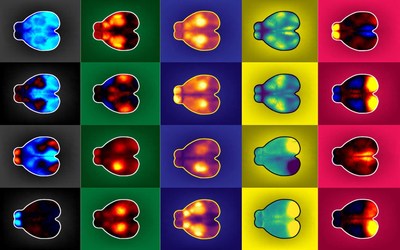Mice also fidget while making decisions
COLD SPRING HARBOR, N.Y., Sept. 24, 2019 /PRNewswire/ -- Humans aren't the only animals that fidget. In a new study in Nature Neuroscience, Cold Spring Harbor Laboratory Associate Professor Anne Churchland and colleagues observed that the neural activity of mice performing trained tasks indicated that they also seemed to fidget while making decisions.

Using wide-field imaging, the team looked at the neural activity all across the top part of the brain in a mouse while it was engaged in decision-making tasks.
For the science community researching cognition, the new results present a major cautionary tale about discerning signals uniquely related to cognitive processes and signals related to background movements, Churchland said. Researchers will have to work to disentangle the two signals from one another, and this study provides guidelines and computational codes on how to correct for it.
The mice in Churchland's lab were trained to make specific movements: grab handles to initiate a trial, and lick one way or the other to report their decisions. The scientists expected to see neural activity related to movements that had to do with handle grabbing or with licking. What they saw was that one seemingly simple task set off a symphony of electrical activity across the mouse brain. It made the team, including the paper's co-first authors, Simon Musall and Matt Kaufman, realize that they weren't thinking about decision making in a very complete way.
They found that most of the activity was driven by uninstructed movements, or fidgets, that the animal was making like hind limb movements, pupil dilations, facial movements, nose movements and whisker movements.
"We thought the animals were a 100 percent focused on our task, and the licking and the grabbing and the deciding," Churchland said. "It turned out that they had their own set of priorities that involved a lot of movements of all different kinds."
Churchland and her lab are still working to understand what these priorities are and how they accompany decisions. To Churchland, an interesting, albeit speculative, idea to come out of the study is that movements are more tightly connected to cognition than people recognized before.
"Maybe the movements are part of the process of thinking and deciding," she said. "There might be this other aspect of fidgeting that people haven't really considered before, which is that it's part of how we call up that cognitive machinery."
Churchland thinks that to understand this link between cognition and movements better, it's worthwhile to look at animals that are genetic models of human irregularities like ADHD, where the amount of movement and the kind of movement are aberrant.
About Cold Spring Harbor Laboratory
Founded in 1890, Cold Spring Harbor Laboratory has shaped contemporary biomedical research and education with programs in cancer, neuroscience, plant biology and quantitative biology. Home to eight Nobel Prize winners, the private, not-for-profit Laboratory employs 1,100 people including 600 scientists, students and technicians. For more information, visit http://www.cshl.edu
![]() View original content to download multimedia:http://www.prnewswire.com/news-releases/mice-also-fidget-while-making-decisions-300923378.html
View original content to download multimedia:http://www.prnewswire.com/news-releases/mice-also-fidget-while-making-decisions-300923378.html
SOURCE Cold Spring Harbor Laboratory
